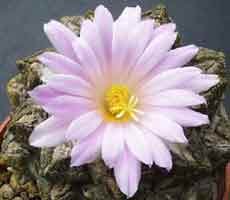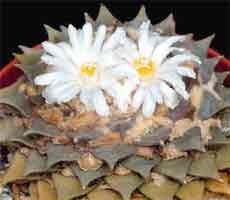|
The Cactaceae, as may
be expected, often play a role in the lives of the people of their
native lands, and the purposes to which the plants are put are as
varied as the plants themselves, and range from building, hedging,
dietary supplements, and religious sacraments.
|
All Ariocarpus species are
known in Mexico by the vernacular name Chaute, (Glue), a reference
to the sticky muciligenous sap found in the stems the plants, this
mucilage has been employed as a glue by the Indian tribes of
Mexico.Ariocarpus fissuratus plays a role in the lives of
several Indian tribes, common names for the species include Peyote
Cimarron and Sunami, the plant has been ascribed magical
properties. The Tarahumara Indians believed Sunami to be more
powerful than Waname (Lophophora williamsii), and used it in
a similar manner, it was also used to in the brewing of an
extremely intoxicating drink. The Tarahumara also believed A.
fissuratus to possess the power to protect against robbers,
having an army of soldiers at its command (Lumholtz 1902).
Ariocarpus kotschoubeyanus is used as a painkiller
especially for blows and bruises, plants are collected and pickled
in alcohol. The plant is known by the vernacular names Pezuna de
venado, and Pato
|
|
 Ariocarpus fissuratus, Sunami,
a pale flowered form of this species. Ariocarpus fissuratus, Sunami,
a pale flowered form of this species.
|

Ariocarpus
retusus, tsuwiri, the false peyote of the Huichol Indian
belief.
|
|
de Venado. Ariocarpus retusus in common
with A. fissuratus was believed to
havemagical properties by the Huichol, to the Indians it was known as Tsuwiri
(false peyote), and was believed to be evil, those that were not
pure, had committed incest, or had received inadequate training by
the tribal shaman would be led to consume the plant instead of the
true peyote Lophophora williamsii. The consequences of
consuming tsuwiri were believed to include madness and even death
unless a cure was administered by the shaman. Ariocarpus
agavoides, is known in the Tula area as Magueyitio, and is
occasionally consumed as a Dulce (Sweet) by the local
population, the mucilage in the roots having a sweet taste.
Ariocarpus bravoanus and A. scaphirostris have also
been reported to be used medicinally.
|
Lumholtz, Carl, 1902. Unknown Mexico. II,
New York: C. Scribners & Sons.
|